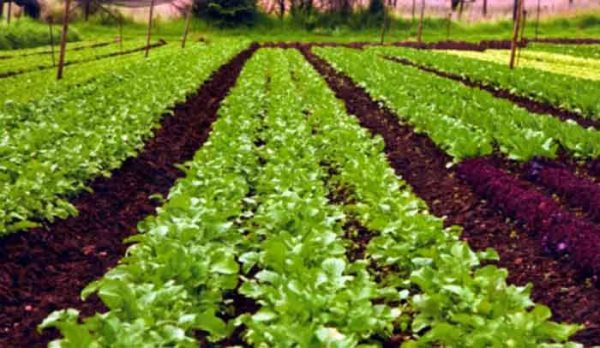Organic Farming: Nearly everyone is aware that eating a balanced diet is essential for maintaining good health. Today, however, foods grown with artificial fertilizers are harmful to our health, including fruits, vegetables, and grains. In this situation, we must inspire the following generation to undertake organic farming alongside us.

To increase the production of food grains and vegetables, hazardous pesticides and a variety of chemical fertilizers are used, which damages both the organic and inorganic elements of nature. As a result, the environment is deteriorating, land fertility is declining, and human health is continuously declining.
Types of Organic Farming
There are two forms of organic farming.
1. Integrated organic farming: Integrated pest control and nutrition management are both parts of organic farming.
2. Pure organic farming: All synthetic chemicals are avoided in organic farming. Clean farming uses natural sources to obtain fertilizers and pesticides. The most productive agriculture is wholly organic. It is said to be a completely organic farming method.
Importance of Organic Farming

The natural ecosystem must be preserved through organic farming. Organic farming protects the resources needed to support life on earth and keeps the environment clean and less polluted. Furthermore, organic farming is introduced to give people wholesome food. As very few or no chemicals enter their systems through food, they become less resistant to serious diseases when they consume organic farming products in the form of wholesome food. In addition, organic farming practices have kept the soil in excellent shape and increased its productivity.
Benefits of Organic Agriculture
The following are a few benefits of organic farming:
- Organic farming offers worthwhile chances for speciality crops
It is possible to start diversifying the crops grown each year thanks to organic farming, which is one of its main advantages. Cash crops are essential to traditional farms’ profitability and viability. As a result, the main crops grown at these facilities are soybeans and maize. Heirloom veggies can be grown by organic farmers, and they might sell them for a higher overall price all year long.
Heirloom crops offer a distinctive flavor profile, the potential for better nutrition, and the capacity to store seeds for subsequent planting. Compared to hybrids, their seeds are usually less expensive.
2. The success of future generations can be aided by organic farming.
The main goal of organic farming is to help our soils heal so that we may continue to use them for crop production indefinitely. This technique teaches us to live and work within our means rather than concentrating on significant short-term gains that can destroy the land and nearby natural resources. It aims to raise rather than lower the values of our planet’s natural capital. Because of this, when organic farming techniques are applied correctly, they can help create long-lasting, sustainable food chains that can feed an expanding population.
3. Natural fertilizers are used in organic farming to increase yields
Farmers that practice organic farming do not simply plant their seeds and wait for nature to do its thing. They use a variety of soil fertilization techniques to support the plant’ expanding support systems. Green manure, worm farming, composting, and the use of cover crops are just a few of the methods that help to stabilize the soil while lowering the risk of pests, weeds, and other possible risks for employees to come into contact with throughout the growing season. Every strategy increases local biodiversity while boosting the fields’ overall output over the long term.
4. Organic farming is a more environmentally friendly way of growing
There are climatic benefits to organic farming as well. The steps taken by this strategy assist in storing carbon in our soils. Since manual labor is used more frequently than mechanical tools, it reduces the amount of energy needed to produce a crop. Utilizing organic materials results in a reduction in the use of petroleum-based products and greenhouse gas emissions. Additionally, it will benefit the prairies and forests that make up our natural ecosystems and serve as carbon storage areas.
5. Organic farming supports insect pollinators.
Farmers that practice organic farming avoid using synthetic pesticides like glyphosate and neonicotinoids, which carry a high risk of harming pollinating insects that support agricultural systems all over the world. These substances were one of the main contributors of Colony Collapse Disorder, according to Harvard researchers. Neonicotinoids, the most widely used insecticides for commercial agriculture, were found to be six times more responsible for the death of honeybee colonies between 2014 and 2015 than the parasitic fungus Nosema.
6. Organic farming provides improved pest and disease resistance
When the root-supporting soil has a naturally high disease-resistance profile, plants develop more robustly. Through this process, the plants gain a better immunological profile that increases their natural resistance to disease and pests. Their defense mechanisms work to repel invaders when there is a suitable pH level and other favorable conditions, such as sunlight and water. It results in thicker plant cell walls, which improves plant growth in general.
7. Organic farming promotes a healthier work environment
When organic farming practices are implemented, local populations, employees, and even farmers are not exposed to synthetic agricultural chemicals. An excessive amount of exposure could raise questions about toxicity. Compared to the general population, those who regularly handle pesticides as part of their jobs are more likely to develop neurological disorders. Along with these distressing symptoms, farmers may also suffer from chronic fatigue, migraines, and memory loss.
8. Organic farming does not use genetically modified crops.
When you purchase organic food, you are getting something that has not had its genetic makeup altered through artificial means. GMOs are not allowed in the sector. Farmers will still cross-breed products to benefit from specific growth characteristics, but this process will be carried out by pollination or breeding rather than genetic splicing and dicing.
9.Organic farming results in better food
Taste profiles and nutritional value are considerably improved when organic farming is practiced. This method of peach cultivation frequently results in peaches with higher polyphenol content, which enhances their flavor. Customers benefit from a higher antioxidant profile because dairy products made from cows allowed to graze on pasture include more vitamin E and omega-3 fatty acids. Even though conventional farming generates a greater amount of food, organic farming raises the food’s overall quality, enabling consumers to consume less.
10. Organic farming contributes to better soils
Farmers commonly use crop rotation to maintain a healthy balance of nutrients in their soil. In the Midwest region of the United States, a typical rotational technique may involve planting corn for one year, followed by oats for the next, before using the area for pasture or hay crops for the next two to six years. This procedure results in higher amounts of organic matter content and improved aeration, which can lead to increased production.
The absence of synthetic fertilizers, insecticides, herbicides, and other chemicals used on the farm’s crops leads to better soils. If the site has received an organic certification, only natural soil additions are permitted.
Disadvantages of Organic Farming
The following are some of the disadvantages of organic farming:
1.Organic farming in the United States lacks a supporting infrastructure
The natural agricultural practices used in this farming model are supported by the lack of infrastructure in the United States. To get food to consumers’ tables, organic farmers use the same commercial transportation methods as farmers of cash crops. This suggests that hazardous practices may still harm the ecosystem even if crops are first grown using soil-friendly techniques.
2. Organic farming does not always take into consideration previous practices.
The benefits of switching from conventional to organic farming strengthen the world food chain. Due to their concentration levels, farmers who change their practices for decades may unfortunately still have a problem with synthetic chemicals staying in the soil. Because their current practices comply with the requirements, farms can still market their products as “organic” in this situation. The food may still contain trace amounts of synthetic substances despite the labeling and precautions taken because of previous manufacturing techniques used on the same piece of land.
3. Organic producers must go through a strict certification procedure.
In the US, there are various categories of “organic,” did you know that? Products that are 100% organic are marked with a specific seal that attests to the fact that all processes follow industry norms. For this labeling option to be available, each product must go through a certification process. For a product to be referred to as “organic,” at least 95% of its constituents must be natural. It is still possible for the product to receive USDA-approved chemical additives before it is sold. If “manufactured from organic materials,” only specific items are produced using industrial procedures.
4. Organic agriculture is rarely supported
This drawback has a significant impact on organic farming everywhere. It will not be common to see direct payments used to artificially raise pricing structures and yields, making going organic expensive for some people. Programs like the Environmental Quality Incentives Program will compensate farmers for switching to organic farming methods. Farmers can get financial aid from some groups to cover the cost of organic certification for their land. Additionally, crop insurance subsidies are offered.
5. Organic farming still employs fungicides and chemicals
When analyzing organic agricultural practices, the word “synthetic” should be taken into account. There is only one prerequisite: the product must be produced using natural resources as opposed to synthetic ones. It is still possible to employ a variety of fungicides and pesticides in organic farming. Since these products require repeated application, which encourages the storage of chemicals in the soil that may exceed permissible concentration limits in some areas, they are potentially dangerous.
6. Organic farming demands more effort than conventional methods
Organic farming needs a significant amount of physical labor to be effective. Workers are required to control weeds and perform cultivation techniques manually. This disadvantage can be reduced by concentrating on biointensive farming or permaculture, but both methods also need a more hands-on approach than conventional cash-farming techniques. Even if you try to experiment with various production processes, finding the ideal mix of procedures that optimize earnings might take years of trial and error.
7.Organic farming faces several marketing challenges to consider
The challenges that organic products encounter are unique. Traditional farmers can sell their crops and agricultural products on a well-established market. They may reach out to local customers, ship to grocery stores, and benefit from the export market. Even though there are alternatives for local markets that operate on specific days, grocery store inclusion, and agricultural co-ops, most communities have varying amounts of access to product sales. This makes it difficult for farmers to sell their products at the maximum profit margins.
8.Organic farming takes specialized expertise to be effective
It is important for organic farmers to understand the ecology of their soil. They must be able to design natural systems that work with their climate and agricultural practices. Farmers must invest time in researching market trends or looking for alternative solutions because support systems for average farms are sporadic at best. This method relies on the expertise of the people who watch over crops throughout crucial growth periods to ensure the plants grow healthily. If you possess this information and the motivation to put it into practice, this strategy will only work for you.


